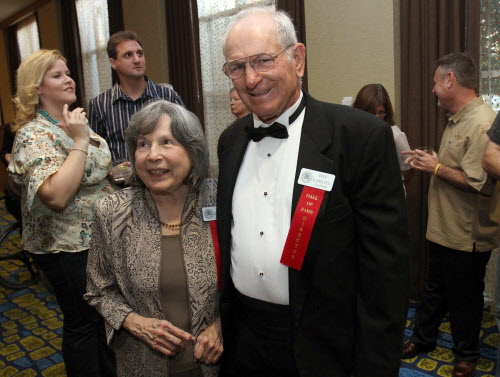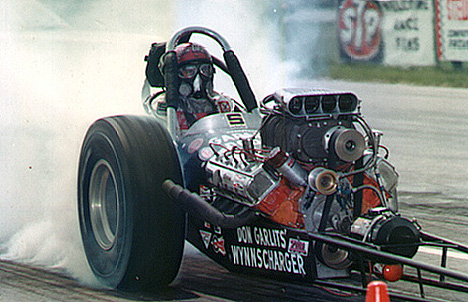The Introduction to
God’s Speed and the Motor Spirit
Don Garlits’ Speed Secrets for a High Performance Life.
"Have patience with all things, but chiefly have patience with yourself. Do not lose courage in considering your imperfections but instantly set about remedying them – every day begin the new task." - Francis de Sales
“I've learned that all the money in the world isn't worth a friendship,” Garlits said. Then, looking right at the 90-year-old Isky, he said “I love this guy.” - Don Garlits addressing Ed Iskenderian at the Rat Roast.
A tribute to Pat Garlits
Posted: Wednesday, February 5, 2014 8:50 am

Pat Garlits has passed away this week after a long illness
I never met Pat Garlits, but I know her through my research for a book I am writing about the life of Don Garlits, entitled God’s Speed and the Motor Spirit.
Pat was as much a racer as was her husband. Her competitiveness and determination coupled with her pragmatism and her ability to see the issues of life clearly and to deal with them effectively, are very distinctive.
The love she had for Don enabled her to support him in a career she would never have contemplated. But as love conquers all, Pat supported Don to become a champion and an inspiration to millions of young men around the world.
Pat Garlits was a champion in her own right as are many women who see their role in life to support a family. Pat Garlits’ faith and life has been an inspiration and a blessing to those who knew her, and also to many she never met, including me. She was indeed, a strong soul.
God bless you Pat for your goodness and your love.
How a street racer became a thoroughly decent man who lived a good life.

Don Garlits’ record as a drag racing champion is unequalled in any motor sport discipline. Garlits singlehandedly redefined the meaning of high performance with dominating accomplishments over more than 30 years. His National Championship win record, pioneering safety and performance innovations and his many “first to” achievements, to say nothing of his gritty tenacity in the face of adversity, are legendary. His legend is all the more remarkable when the story of his transition from a clandestine street-racing hot-rodder to the elder statesman of the sport is known.
Garlits’ image of a victorious champion kissing the race queen is juxtaposed by images of him sitting in a high-speed inferno of oil and nitro methane following an engine explosion, or incredibly, sitting in the back half of his dragster, cut in two by a transmission explosion, or again, his 30 foot-long car doing a back-flip at over 200 miles per hour. His resolution of courage and fear, against his sense of responsibility for his family and determination to succeed when faced with impossible odds, are a demonstration of his intelligence, skill, ambition, focus, dedication and persistence combined with reluctance to accept defeat.
Don’s influence on motor sport extends far beyond the narrow confines of the drag racing fraternity. He reaches to the far corners of the globe, where for decades, thousands of young men, absorbed every news item about him in the world’s largest automotive publication, Hot Rod magazine.
A love story of Don & Pat Garlits

Garlits’ greatest speed secret is his wife and his greatest supporter, Patricia, who encouraged his racing by accompanying him on marathon trips from Florida to dusty, isolated drag strips all over the USA in the early years of the sport. In moments of pure inspiration, she literally saved his life and guided him to unimagined success, enabling him to turn his detractors’ taunts of “swamp rat” into the motif of a dominating competitor. Ultimately, it was Don Garlits’ deep love for Pat, that created the conditions for success and the beginning of an adventure that allowed Don to become internationally recognised as “Big Daddy”, a revered spokesman for the sport, but more significantly, to be recognised as a thoroughly decent man who lived a good life.
Despite his celebrity and wide public acclaim, Don Garlits remains an enigma, well known as a tough competitor who hates losing, and as a man interested in the arcane world of extra-terrestrials. Contrary to the supercharged macho image of drag racing but consistent with his alternative views, Garlits displayed a large cross on his car with the words, “God is Love” to signify the source of his inspiration.
This book holds these tensions and attempts to answer questions about Garlits motivation and vocation as they relate to a sense of purpose and to what he sought to accomplish. I will explore these imponderables as they are distilled into more manageable questions such as; what is a good life? How is it achieved?
A king of another realm
In an attempt to consider and resolve the apparent contradictions between Don Garlits’ ordinary human motivations and the highest of human achievements, I have drawn an unlikely parallel between the life Don Garlits and a king “par excellence” of another realm, Solomon, who achieved all that was possible, but remained unsatisfied.
I believe that if the good life is achievable by all who seek it rather than the exclusive domain of a king, who himself cannot find it, then I contend that it must be possible for an ordinary man, like Don Garlits, doing ordinary or extraordinary things like drag racing to become what the Bible calls, “ministers of the new covenant of the Spirit which brings life”. If this can only be achieved by a saint, a mystic or a guru, then life is a mystery that cannot be solved or become satisfying to an ordinary person. Therefore, I will argue that it is necessary to ask the question within the scope of ordinary experience: What do I want? What is best? What is good, what is the ultimate good; the good life and how do I obtain it? To not look for an answer suggests that we have settled uncritically for whatever comes our way. We then become victims of fate over which we have no control. I contend from Don Garlits’ life and my own experience that such satisfaction is achievable if we allow ourselves to become possessors of strong souls.
The title of this book, God’s Speed and the Motor Spirit suggests a different understanding of what the “rules” of faith in God are, and what they are intended to achieve. They are not to slow us down, but to guide, to speed up and to facilitate our enjoyment of the good life. The second part of the title, Motor Spirit, is about how we get up to speed, not by rigid compliance with the rules, but by our openness and willingness to embrace the enabling power freely available to us.
My purpose is to recount how the story of Don Garlits can be a metaphor of how to find fulfilment and purpose, as I don’t wish your life-energising ambitions to “go up in smoke”, (as drag racers say) indicating a loss of traction and the hapless spinning of your wheels.
Words on a page have no meaning until they have been tested in our imagination and applied in real life - CS Lewis
“Best fit parabola”
This story requires some use of imagination and lateral thinking. You may need to suspend rationalisation for a little while to continue to read. This style of writing is what I call a “best fit parabola”. This is an attempt to make informed guesses about a subject that is too difficult for ordinary motor-head minds like mine, to grasp. Mechanics are good problem solvers, but we are not normally good abstract thinkers or engineers, otherwise, we would be designing cars and not getting our hands dirty fixing them.
A best fit parabola attempts to do what many great teachers have done. Jesus, Socrates, Blaise Pascal and others who gathered their students by drawing them into a topic they find to be interesting, and then telling a story with a parallel meaning and asking the students questions that require reflective thought and real life application, of what they think may be true, keeping in mind the drag racers maxim, it is only true if it results in a higher speed or a lower elapsed time over the quarter mile.
Blaise Pascal scornfully said that simple workmen had been able to convince of error those great men that are called 'philosophers'. It was, then, these unlearned men... who were most ready to believe 'what they saw with their eyes and touched with their hands'.
You will find I have not referenced some sources. Most are easily obtained on the Internet by Google. If you do take the trouble to go looking, I ask the you read as many related references as you can easily find, and allow the Motor Spirit a little time to do His work on you before you decide what it all means and what you must do next.
Ecclesiastes
Ecclesiastes is by far the most obscure of all the books in the bible. Ecclesiastes is poetic in style, purposefully filled with paradox, if not real contradiction, to reflect the complexities of the life of King Solomon. Ecclesiastes was apparently recited during the Jewish Sukkoth festival, to remind the participants of the vagaries and complexities of life, and to prevent them from jumping to conclusions about their possibly superficial motivations, passions and satisfactions.
Although Ecclesiastes is unlikely to be written by Solomon, it is certainly about him as told by “The Teacher” also known as Qoheleth, whose name I use interchangeably with Solomon for the sake of simplicity, although I acknowledge they are not the same person.
There are two teachers in scripture who have much to tell us if only we will listen. One teacher is Quoleth, the other is Jesus.
GodSpeed
Warren Mills
November 2013
A note regarding referencing. References in this book are generally not given unless they are in the text. Bible references are from the New International Version unless otherwise cited. All quotes are designed to be inserted into Google and the original source found and studied in its context, in conjunction with similar supporting sources. I request that readers do not “cherry pick’ biblical references as “proof texts”, rather, please study topical themes to derive meaning, as I have found this method to be a powerful tool to gaining clear concepts as a foil against reductionist points of view.